
Design and Development of Machine-Learning Based Portable IoT-Device for Clinical Detection of Foot-and-mouth disease in Livestock
Often livestock in farms become affected by the Foot-and-Mouth Disease (FMD) due to poor maintenance. This is a highly infectious and sometimes fatal viral disease and poses serious issue to animal farming. The transmission of the FMD virus is possible before an animal has apparent signs of disease, and this aspect of low-detectability at early stages increases the risk of significant spread of the virus before an outbreak is detected. Further the FMD virus can be transmitted in many ways, including close-contact, animal-to-animal spread, and the carriers can be even inanimate objects, such as fodder and motor vehicles. The incubation period for FMD is 14 days. It is reported to be 1 to 12 days in sheep, with most infections appearing in 2 to 8 days; 2 to 14 days in cattle; and usually 2 days or more in pigs, with some experiments reporting clinical signs in as little as 18 to 24 hours [1]. This disease is still prevalent and the current approach to control the spread by large-scale culling results in adverse economic and environmental effects and is traumatic for farm workers and the public. The first major FMD outbreak in the U.K. in 2001 is estimated to have cost the country at least $6 billion, and another major outbreak happened in South Korea in 2010/11, with an estimated impact of about $8 billion. Though the livestock can be protected against FMD by vaccination, non-endemic countries do not vaccinate for FMD preemptively because of the cost of vaccination. However, they must be prepared to act at the first sign of infection. Hence, early detection of clinical signs of FMD is very critical.
We propose to design and develop a portable IoT device based on machine learning (ML) algorithm using FPGA platform that can be used in the preliminary investigation of clinical signs due to FMD. The typical clinical sign is the occurrence of blisters on the nose, tongue, or lips, inside the oral cavity, between the toes, above the hooves, on the teats and at pressure points on the skin. For training the ML model, currently available images of clinical signs of FMD and the corresponding diagnosis will be used for classification. After the model is trained, the portable device can be taken to the farm, and the images of the clinical signs of the suspected animal can be captured. Then the device will classify the diagnosis with a confidence score. Based on this, further investigations, if required, can be taken up.
[1] OIE Technical Disease Card: Foot and mouth disease, World Organization for Animal Health, Sep. 2021. [online]. Available: https://www.oie.int/app/uploads/2021/09/foot-and-mouth-disease-1.pdf
Demo Video
Project Proposal
1. High-level project introduction and performance expectation
Agriculture plays a crucial role in our day-to-day errands; dairy farming plays the second most important role after crop cultivation; so, the maintenance of cattle health is essential. Foot and Mouth disease is a viral disease prevalent among cattle. The emphasis of the project is premature detection of the FMD to avoid huge loss and to provide pre medication to suppress the severity. The FPGA device is trained using an ML algorithm to predict the health of the cattle when the image is captured. Here, we expect our model to predict how much percent the imaged cattle falls into the category Diseased and Healthy and the result is displayed. The device is trained using the Support vector machine algorithm in python supported by the libraries numpy, pandas, sklearn, pickle.
PURPOSE OF DESIGN:
There is a need for the veterinarian to visit the cattle shed to examine the suspected cattle or the cattle should be transported to the hospital, this causes a factor of delay in the treatment of the disease which may deepen the severity. Hence if a portable device for the disease prediction is made available for farmers and cattle keepers, it would ensure them with the probability of the disease in no time, and further medication could be done rapidly saving the cattle and bringing it back to its healthy state.
PROBLEM MOTIVATION:
Cattle in remote and non developed areas are subjected to culling in mass amounts due to the lack of awareness among the farmers. If the affected cattle are larger in number it will also be difficult to transport them to the hospital for treatment and medication. When the device predicts a cattle as diseased it can be isolated; this avoids the further transmission of FMD to other cattle. Reducing the number of cattle deaths and Transmission rate is focussed in this project.
TARGETED USERS:
1. Livestock owners
2. Farm owners
3. Dairy factories
4. Beneficial for the researchers examining the cattle
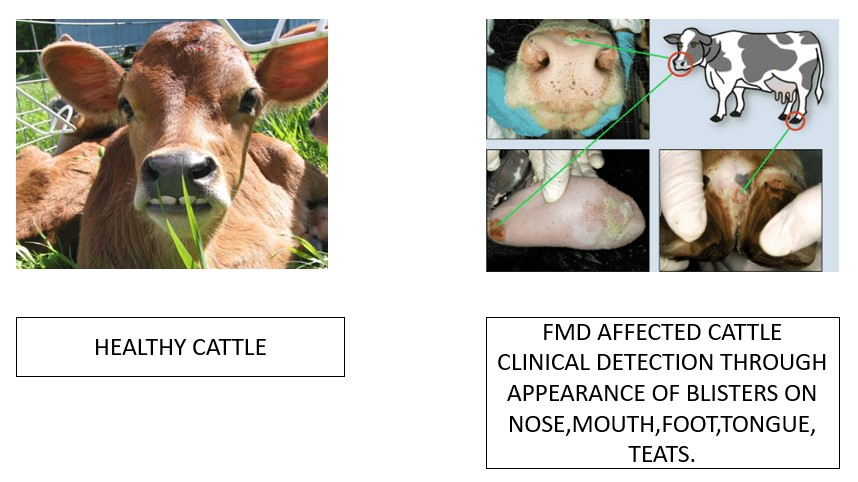
2. Block Diagram

The proposed portable IOT device based on machine learning algorithm uses DE 10-Nano Cyclone V SoC FPGA board. The FPGA board will interface with a camera module to capture the clinical sign images of the suspected cattle. The images captured are sent to FPGA for further processing using machine learning algorithms. The ML model predicts whether the cattle is infected by FMD and provides a confidence score.
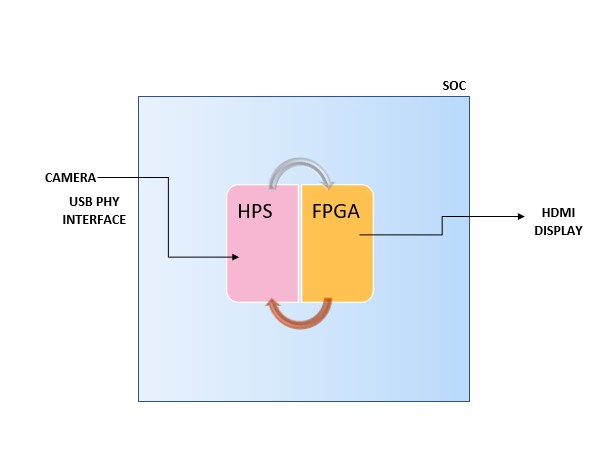
The final model looks as shown above, HDMI display and Camera interfaced with the FPGA and HPS respectively.
3. Expected sustainability results, projected resource savings
By employing the portable device for foot and mouth disease prediction, it is possible to save the life of livestock and also prevent a massive infection outbreak. The proposed design is expected to detect accurately whether the cattle is infected with FMD virus or not. Further, since the solution is based on a machine learning algorithm, the accuracy of detection can be continuously improved. As the proposed solution is built on a portable FPGA, the results are available almost as soon as the images of suspected cattle are captured.
The main advantage of our proposal is the early detection of the FMD infection and faster treatment, so that the spread of FMD virus can be contained. The sustainable aspect of our proposal is to save the lives of millions of cattle and to avoid the emotional and economic consequences for livestock breeders.
RESOURCE SAVINGS:
On the analysis taken in Bangladesh during the period from July 2017 through June 2018, on examining 1,388 cattle it was found that 343 among them were clinically affected with the FMD nearly 24.7 percent of the cowherd has been affected. The indegenous breeds of cattle were more susceptible compared to the exotic and crossbreeds. This results in the production loss.
Nakuru county in Kenya recorded the highest percent of FMD outbreaks during the year (2010-2016) reaching upto a percent of 69.3 percent of FMD infected cattle.
These losses of cattle lives must be reduced to save cattle and to avoid any economic crisis.
The resource savings include avoidance of enormous cost incurred due to culling of a large number cattle that are infected with the virus.
To avoid further spread, most times, cattle that are not infected but assumed to be potential carriers of the virus are also culled.
The additional advantage of our proposal is that frequent checks can be easily done onsite ensuring early detection and thus saving considerable time and cost due to veterinarian visits.
4. Design Introduction
The proposed portable IOT device based on machine learning algorithm uses DE 10-Nano Cyclone V SoC FPGA board. The FPGA board will be interfaced with a camera module to capture the clinical sign images of the suspected cattle. The images captured are sent to FPGA for further processing using machine learning algorithms.The algorithm used in the project is Support Vector Machine. The ML model predicts whether the cattle is infected by FMD and provides a confidence score. The GUI application is developed so that it can be easily accessed by the end users.
PROGRAM FLOW:
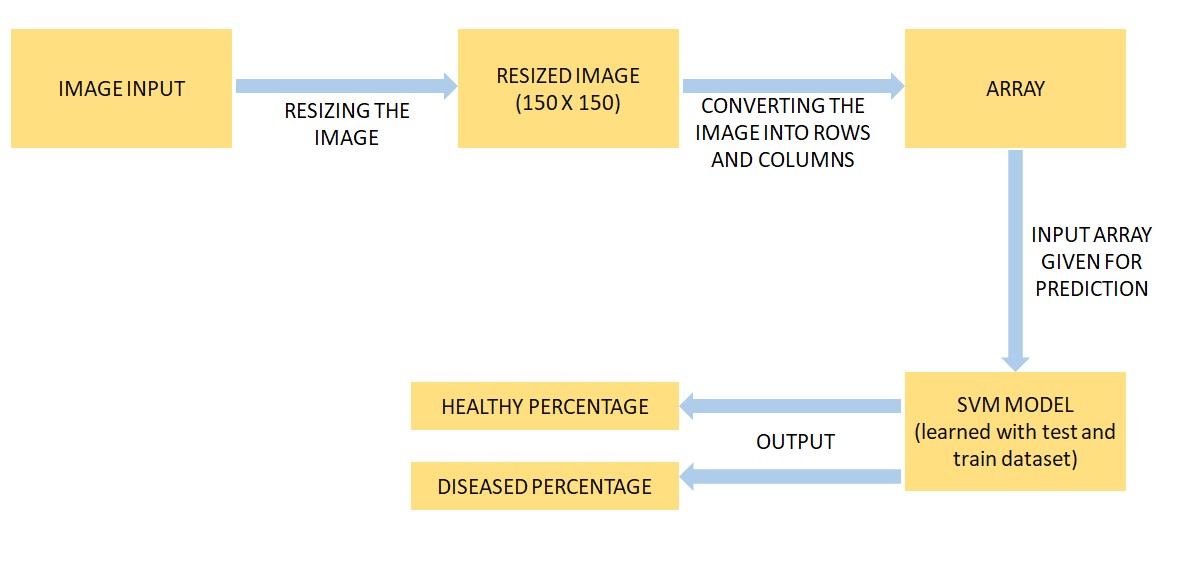

APPLICATION SCOPE:
The designed portable device can be employed by dairy farms with a significant number of cattle where consistently monitoring their health is difficult.
The device also finds its application in farms where reaching veterinarians at the earliest is not possible.
The main scope of this application lies in the early detection of infection and prevention of a massive outbreak of the same. The use of FPGA further enhances the efficiency of detection of this disease since the device employs machine learning algorithms.
The device can be extensively used by farmers especially in remote and isolated areas, where easy accessibility of veterinarian is a constraint. The device can be used as a primary health prediction monitoring device in farms, agricultural lands and dairy industries. Since the usage of the device is simple and comprehensible, it is easy for the cattle owners in continuous monitoring and data collection of their cattle.
WHY FPGA?
FPGA excels in its computational capacities, particularly with computation involving images. After a long consideration of various microprocessors, it was concluded that the use of FPGAs in this project will further enhance the detection efficiency owing to its parallel processing feature and thus faster and more accurate results can be obtained. The form factor of the FPGA board required is also small making it very convenient to carry.The FPGA surpasses complex logic computing in very less time. It’s high processing ability also makes the FPGA cost effective.
5. Functional description and implementation
The portable device based on machine learning algorithm uses the following hardware components
1. DE 10-Nano Cyclone V SoC FPGA board
2. Camera
3. HDMI monitor
The camera, which is connected through the USB PHY interface, is used to capture images of cattle, which are then processed in the HPS part of the board.
For the classification of diseased and healthy images, the support vector machine (SVM) algorithm is used. The images in the dataset are pre-processed and resized (150 x 150) and then it is used to train the SVM model.
A GUI application is integrated with a pre-trained model. The GUI implemented in the project makes the portable device easily accessible and user friendly.
The images after being processed are fed to a pre-trained model which is executed on the board for the prediction of foot and mouth disease in cattle.
The device assigns a probability to each class and this is implemented through SVM classifier taking an image of cattle as input and outputs two probabilities to the two classes (Healthy and Diseased).
The HDMI port of the FPGA is connected to a HDMI display monitor and the output with confidence score is displayed on it.
IMPLEMENTATION:
Hardware Design Scheme:

Software Design Scheme:
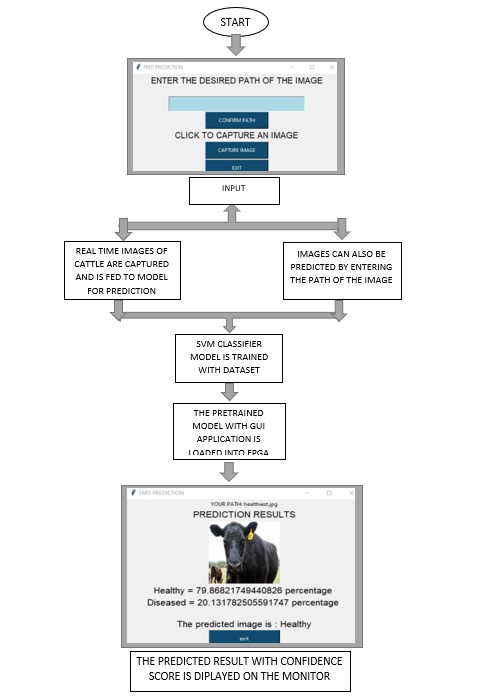
6. Performance metrics, performance to expectation
Algorithm used: Support Vector Machine (SVM)
SVM has the higher accuracy percent compared to the regression and binary tree methods. Since the data we feed for training is non-linear, SVM is more preferred as the kernel used in SVM transforms our input data into the required form . The lower dimension input space is transformed to the higher dimension. As a result, our SVM model now converts the non separable data into separable by adding more dimension, more dimension benefits us by differentiating the attributes more precisely leading to an accurate model. The kernels employed in the SVM are the Polynomial kernel and the Radial Basis Function kernel (RBF).
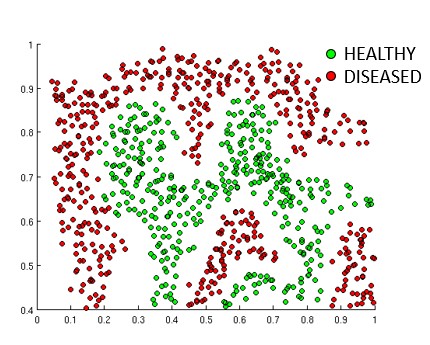
The above graph shows how an RBF kernel can choose a non linear decision boundary to classify the Healthy and Diseased category.
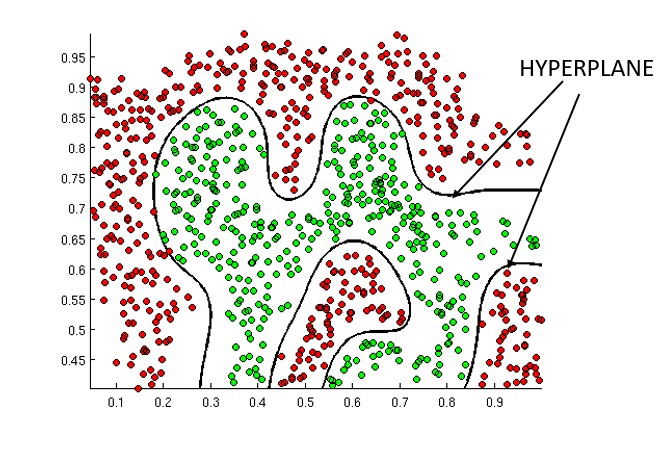
The Hyperplane is now plotted separating both the classes.The gamma values used in the algorithm are 0.0001, 0.001, 0.01 ,0.1, 1. Gamma value fits the training dataset and helps in determining the hyperplane, depending on our input data the gamma value gets trained in a way that overfitting of the model is avoided.
Expected performance parameters:
Accuracy: The algorithm is expected to be implemented with the probability of omitting the occurrences of False positives and False negatives, expecting an overall accuracy of 70%.
Sensitivity: SVM has a higher sensitivity to certain types of spatial patterns than other algorithms, making it one of the best suited algorithms for the task. The sensitivity of the device also extends to the detection of the disease in case of the cattle, if it shows mild symptoms.
Adaptability: The dataset which is used for training the algorithm comprises of various images of different orientations and conditions (eg. lighting etc.,) for enhancing the adaptability of the device.
Reliability: The SVM, trained with enough data becomes a very reliable algorithm producing accurate results enhancing the reliability of the device.
Efficiency: Since the algorithm employed is SVM, the algorithm by itself is very accurate and efficient once it is trained enough.
BENEFITS OF USING FPGA:
The FPGA is a highly parallel computing device that is ideal for real time application development. The FPGA in this project is configured from the Hard Processor System (with the LXDE Desktop).The FPGA supports the lightweight desktop environment making the usage more compatible and user friendly. The 800Mhz processor speed makes the application of disease detection within a few seconds. The SDRAM in the board helps in the rapid execution of the instructions thus increasing the number of instructions performed in a given time.
7. Sustainability results, resource savings achieved
1. Monitoring ensures that the cattle is healthy and hence can result in improved quality and quantity of milk production.
2. Resources spent on the veterinarian can be minimized.
3. Saving lives of the cattle.
4. Minimizing the outbreak of the Foot and Mouth Disease
5. Educating the farmers and creating awareness among cattle owners about detection of Foot and Mouth Disease
6. Increase in Dairy production and boosting economic growth.
7. Laboratory diagnosis and vaccines can be administered at the early stage reducing the severity and narrows the spread rate.
8. The prior diagnosis of the FMD helps in stabilizing the dairy industry and reducing economic losses
9. The level of food security is increased since the detection of FMD at the early stage reduces the impact on the resources.
8. Conclusion
All cattle owners along the cattle marketing chain incur losses during FMD outbreaks, so preventing the outbreak of FMD should be achieved for disease free and a healthy farm. Since our device is portable, convenient and accurate, it can be used to detect Foot and Mouth Disease in cattle.
3 Comments
Please login to post a comment.
Rohit Athithya
By not having to wait for veterinarians and having remote detection of disease, offers a great leverage in maintaining a livestock. I feel that once this product is developed completely, it would help both the owners and the doctors to treat the animals.
Krishnamurthy
It's very much useful tool for farmers; this will protect the cattle and avoide the huge loss.
Vasu C L
A very useful tool in the hands of farmers; this will not only protect livestock, but will also ensure that cattle farming is profitable.
A practical application of machine learning using FPGA